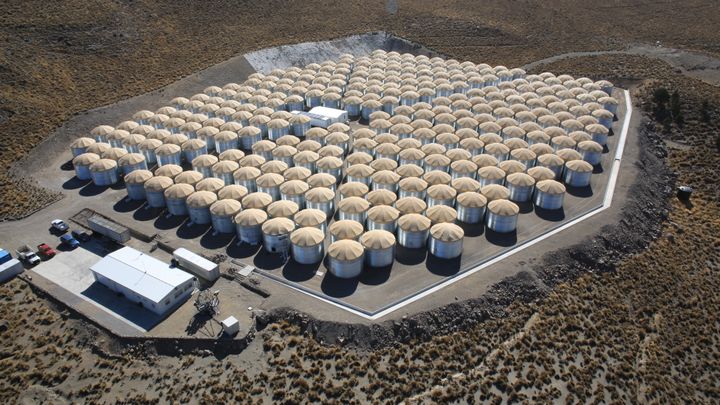
The HAWC Observatory above Puebla, Mexico.
This post first appeared in National Geographic’s blog Voices.
By Andrea Albert
Fourteen thousand feet above sea level near a volcanic peak in Mexico sits a unique astronomical observatory. Instead of peering into space with a glass lens, it uses 300 huge barrels of water. And instead of focusing light, it aims digital sensors inside of each barrel to detect a ghostly blue light called Cherenkov radiation from high-energy particles whizzing through the water. In my work as one of the astrophysicists using the High-Altitude Water Cherenkov Observatory, better known as HAWC, I sift through data from those mountain-top water barrels looking for the fingerprint of one of the most elusive yet abundant quarries in the universe: dark matter.
Dark matter is invisible, but we know it’s there because we can detect its gravitational pull. Overwhelming evidence points to dark matter making up 85 percent of the total mass of the universe. Dark matter is literally holding the universe, including our own Milky Way Galaxy, together.
So what exactly is dark matter? The leading theory considers it to be weakly interacting massive particles, poetically called WIMPs. We think WIMPs are 10 to 10,000 times more massive than a proton, yet their weak interactions with ordinary matter make them difficult to detect. Observations suggest a halo of dark matter surrounds galaxies, making their outer spiral arms rotate more quickly than the gravitational force of regular matter can account for. Other observational evidence reinforces the WIMP theory. But how can we prove it?
Theory predicts that when WIMPs whack into dark antimatter particles, they’re going to annihilate and emit a cascade of other particles that give off gamma rays, the most energetic photons (particles of the electromagnetic spectrum). But those annihilations are rare. That’s why we’re using HAWC to look at entire galaxies—they contain lots of dark matter particles. Gamma rays don’t reach the surface of the Earth, which is good for us, because they can be dangerous. Earth’s atmosphere absorbs that energy, turning it into lower-energy photons and electrons that all bear a distinctive signature revealing their gamma ray origin.
I’m working with HAWC to test the WIMP theory of dark matter. As a national nuclear security facility, Los Alamos National Laboratory studies dark matter under its global security mission, which includes a focus on particle physics. Increasing our understanding of high-energy astrophysical phenomena helps us develop expertise and capabilities in particle detection, data acquisition systems, and Big Data analysis. That work brought me to the HAWC team at Los Alamos, where I could pursue the deep mystery of dark matter.
One of our searches uses this unusual telescope to look for gamma rays from relatively near dwarf galaxies. They’re unusually dim given the number of stars in them and are known dark matter hangouts. If we do see gamma rays coming from them, that would be a smoking gun for dark matter interactions. When these particles hit the water in the HAWC barrels, they give off the distinct blue track of Cherenkov radiation. Knowing which barrels are hit and when, we can figure out where in the sky the particle and its parent—a gamma ray—came from. Only a few known phenomena can accelerate particles to the tremendous energies needed to create gamma rays, including the shock wave produced by a supernova; the super dense rapidly rotating star left over after a supernova, called a pulsar; or a super massive black hole in the center of a distant galaxy. Those gamma-ray sources don’t exist in dwarf galaxies, which means if a gamma ray came from a dwarf galaxy, then chances are it came from dark matter annihilation.
I like to think of myself as a detective and all those barrels as my magnifying glass as I search the universe for bursts of gamma rays. It’s analogous to a detective tracking a murder suspect. You find leads and you follow up on them, but you need several pieces of evidence pointing to the same person before making an arrest. Sometimes even a smoking gun with fingerprints isn’t enough to get a conviction, so you keep asking questions in an on-going investigation. HAWC is asking some of the best questions yet, and we hope to get answers back from the cosmos soon.
Andrea Albert is a particle astrophysicist and the Marie Curie Distinguished Postdoctoral Fellow at Los Alamos National Laboratory where she hunts for dark matter signals using both the Fermi Large Area Telescope and the HAWC Observatory, which sits in the mountains 14,000 feet above Puebla, Mexico.
